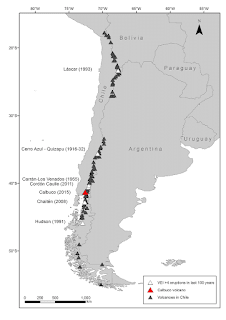According to the Smithsonian website, Chile has 91 Holocene volcanoes. Ten of those have erupted within the last 20 years. Most large volcanoes in Chile are stratovolcanoes also called composite volcanoes. They are tall and cone-shaped made up of many layers of hardened lava and volcanic ash. Cinder cones are smaller than stratovolcanoes and are steep and cone-like in shape. In Chile there is also plenty of hydrothermal activity and is found where there is volcanic activity under the Earth’s crust. Geyser is a type of hot spring that erupts regularly, throwing hot water and steam into the air. There are also hot springs and fumaroles in Chile.
The Southern Andean Volcano Observatory (Spanish: Observatorio Volcanológico de los Andes del Sur), also known by its acronyms as OVDAS, is part of Red Nacional de Vigilancia Volcánica, a program of the Chilean National Geology and Mining Service to watch the 43 most dangerous volcanoes of Chile. In 2012, there were 30 volcanoes under observation.
Based off the USGS website, the eruption of the Chaitén Volcano in Chile, on May 26, 2008 influenced the Chilean government to plan a National Volcano Early Warning System (NVEWS) modeled after a 2005 USGS report proposing a monitoring strategy for U.S. volcanoes. The strategy ranks hazards posed by volcanoes into threat levels, assesses the monitoring gaps, and recommends upgrading the monitoring capability according to the threat level. This monitoring network assists them to transmit data in real time to help warn the public of further eruptions. This system will ensure proper evacuation time and could save countless lives.
Sources:
Global Volcanism Program | Chile Volcanoes (si.edu)
List of volcanoes in Chile - Wikipedia
Volcanoes of Chile | Chile Culture
Map-of-active-volcanoes-in-mainland-Chile_Q320.jpg (320×320) (researchgate.net)





